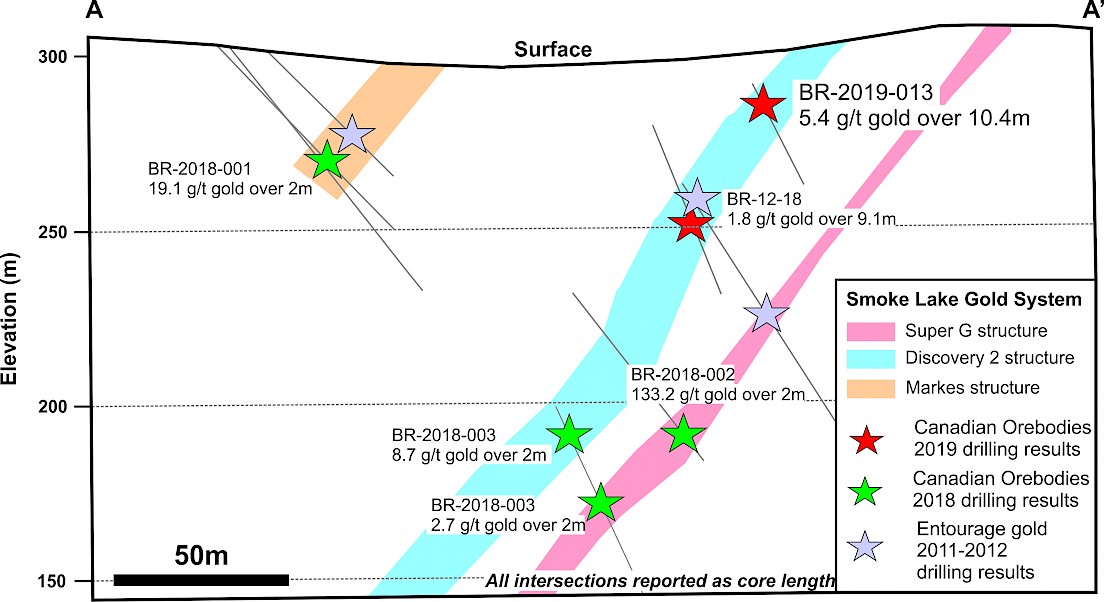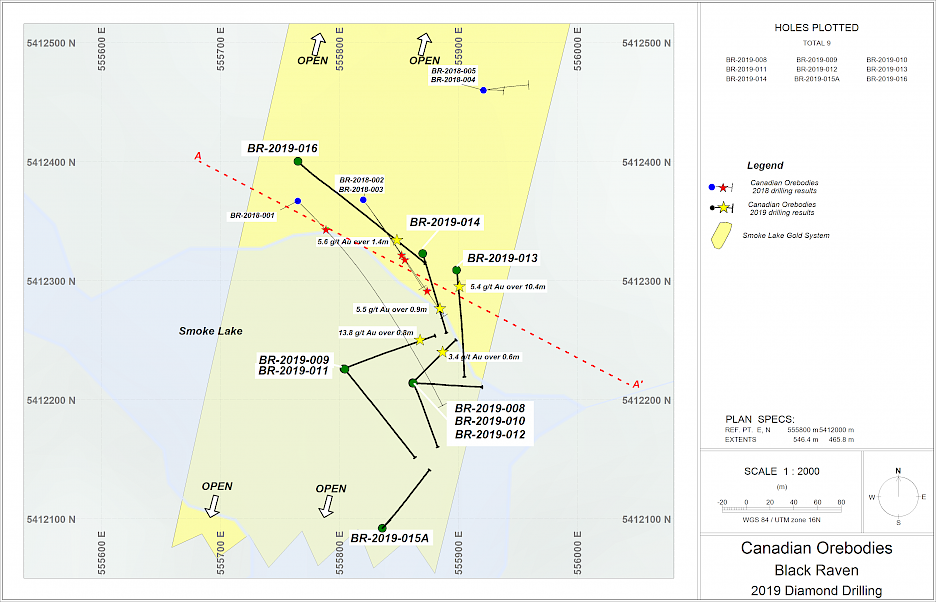TORONTO, June 11, 2019 -- Canadian Orebodies Inc. (the “Company”) (TSXV:CORE) is pleased to announce the results of its drill program to explore the high-grade gold-bearing veins in the Smoke Lake Gold System (“SLGS”) on the Pic Project (see press release dated February 22, 2019, formerly referred to as the Black Raven property).
This drill campaign consisted of 10 holes totaling approximately 1,305 metres, with the majority of the holes drilled off ice pads on Smoke Lake. The results from the program further illustrates that the Smoke Lake Gold System is formed of multiple gold-bearing structures, that high-grade gold mineralization can be found in any of these structures, and that zones of potential thickening could be present in these structures. The results of this drill program also suggest that haloes of lower grade mineralization could be found around the Super G and the other higher-grade veins of the Smoke Lake Gold System.
Highlights:
- Discovery of a near-surface high-grade structure in the SLGS - BR-2019-013 contains 5.4 g/t gold over 10.4 metres including 12.0 g/t Au over 4.3m only 17 metres from surface (Figures 1 & 2, and Table 1);
- Hole BR-2019-013 contains 6.4 g/t Au over 2.0 metres, including 15.9 g/t Au over 0.8 metres in the Super G structure of the SLGS;
- Hole BR-2019-009 intersected 2.1 g/t Au over 8.6 metres including 13.8 g/t Au over 0.8 metres in the Super G structure of the SLGS;
- Identification of significant zinc enrichment at the contact between volcanic units suggestive of a VMS style system.
Table 1 – Significant intersections in the Smoke Lake Gold System
Hole | From | To | Interval | Au (g/t) | Zn | Visible gold | Structure |
(m) | (m) | (m) | uncut | (wt. %) | in SLGS | ||
BR-2019-008 | 61.1 | 70.7 | 9.6 | 0.4 |
| - | Super G |
incl. | 69.7 | 70.7 | 1.0 | 3.0 |
| - | |
BR-2019-009 | 96.2 | 100.7 | 4.5 | 0.5 |
| - | Discovery |
and | 118.6 | 127.2 | 8.6 | 2.1 |
| - | Super G |
incl. | 126.4 | 127.2 | 0.8 | 13.8 |
| VG | |
BR-2019-010 | 87.0 | 87.6 | 0.6 | 3.4 |
| - | Super G |
BR-2019-011 | 76.2 | 79.6 | 3.4 |
| 0.7 | - | Zinc Discovery |
BR-2019-012 | no significant results | ||||||
BR-2019-013 | 12.5 | 22.9 | 10.4 | 5.4 |
| - | Discovery 2 |
incl. | 18.6 | 22.9 | 4.3 | 12.0 |
| - | |
incl. | 18.6 | 19.4 | 0.8 | 35.4 |
| VG | |
and | 77.4 | 79.4 | 2.0 | 6.4 |
| - | Super G |
incl. | 78.6 | 79.4 | 0.8 | 15.9 |
| VG | |
BR-2019-014 | 38.1 | 45.8 | 7.7 | 0.7 |
| - | Discovery 2 |
incl. | 44.7 | 45.8 | 1.1 | 2.0 |
| - | |
and. | 94.6 | 101.9 | 7.3 | 1.1 |
| - | Super G |
incl. | 94.6 | 95.5 | 0.9 | 5.5 |
| - | |
BR-2019-015A | no significant results | ||||||
BR-2019-016 | 43.2 | 45.5 | 2.3 | 1.6 |
| - | Markes |
incl. | 44.7 | 45.5 | 0.8 | 4.3 |
| VG | |
and | 57.6 | 58.6 | 1.0 |
| 1.28 | - | Zinc Discovery 2 |
and | 161.7 | 171.2 | 9.5 | 1.1 |
| - | Super G |
incl. | 168.5 | 169.9 | 1.4 | 5.6 |
| - | |
(*Assay results reported over intersection length. Additional drilling is required to estimate the true width of the mineralized structures forming the SLGS.)
HOLE ID | EASTING | NORTHING | ELEV | AZIMUTH | DIP | DEPTH | TARGET |
BR-2019-008 | 555861 | 5412213 | 300.176 | 91 | 61 | 117 | Super G |
BR-2019-009 | 555803 | 5412226 | 300.1 | 68 | 58 | 150 | |
BR-2019-010 | 555861 | 5412213 | 300.176 | 45 | 66 | 126 | |
BR-2019-011 | 555803 | 5412226 | 300.1 | 142 | 57 | 165 | |
BR-2019-012 | 555862 | 5412214 | 300.1 | 68 | 58 | 114 | |
BR-2019-013 | 555898 | 5412308 | 301.5 | 173 | 46 | 126 | |
BR-2019-014 | 555870 | 5412322 | 300.3 | 163 | 60 | 135 | |
BR-2019-015 | 555836 | 5412092 | 300.3 | 43 | 58 | 36 | Abandoned in overburden |
BR-2019-015A | 555836 | 5412092 | 300.3 | 43 | 58 | 121 | Super G |
BR-2019-016 | 555764 | 5412401 | 310.0 | 131 | 50 | 216 | Super G + Markes |
“Our winter drill program was successful in demonstrating and reinforcing our theory that the Smoke Lake Gold System is comprised of numerous high-grade gold bearing veins. The discovery of a high-grade vein in hole BR-2019-013 only 17 metres from surface is very encouraging and highlights the underexplored potential of this emerging gold system,” said Gordon McKinnon, President and CEO of Canadian Orebodies. “Not only was the program successful in the discovery of new veins, it also produced several of the widest core intersections to date in the SLGS, with BR-2019-013 cutting 10.4 metres of 5.4 g/t Au*. The fact that we were able to discover new veins in our last two programs, combined with significant thickening of certain zones seen from this campaign, certainly is an encouraging development for the SLGS.”
Figure 1: Smoke Lake Gold System Section

Figure 2: Smoke Lake Gold System Plan Map

Smoke Lake Gold System
The objectives of the first 2019 drilling program were to test the extension of the Super G structure under Smoke Lake and to better define the mineralized structures of the Smoke Lake Gold System. The winter drill program was successful as the results prove that the Super G vein is one component of a larger gold system in which four gold-bearing structures have been identified. The results of the drill program further demonstrate that high-grade gold mineralization can be found in all the known mineralized structures of the Smoke Lake Gold System, and that near-surface high-grade mineralization can be discovered in the area. Interpretation of the structural measurements of the oriented core indicate that multiple vein orientations can be found in the mineralized structures of the Smoke Lake Gold System. The structural complexity observed near the higher-grade intersections suggests that structural intersections could be favorable targets for high-grade mineralization. The company will further refine this hypothesis during its summer 2019 field program in the Smoke Lake area. Additional drilling will be necessary to establish the continuity of gold mineralization in the different gold-bearing structures that form the Smoke Lake Gold System.
Base metal potential identified in the Smoke Lake Gold System
The integration of the multi-element analyses from the 2019 drilling program with the multi-element analyses from the previous drill programs has identified zinc and copper anomalies occur along the contact between the volcanic units in the area. In diamond drill core, the zinc ± copper anomalies occur within zones of silicification and veining with variable sphalerite and accessory chalcopyrite. The location of the base metal anomalies preferentially located at the contact between volcanic units suggests that exhalative periods may have happened between periods of active magmatism and that volcanogenic massive sulphide (“VMS”) mineralization could have been formed, which could represent additional targets.
Analytical methods and Quality Assurance/Quality Control (QA/QC”) Measures
Canadian Orebodies has implemented a quality control program to comply with best practices in the collection and analysis of drill core. All drill cores are BTW in size and assays are completed on sawed half-cores, with the second half of the core kept for future reference. Groups of samples are then placed into durable rice bags and then transported in security-sealed bags to Activation Laboratories Ltd. in Thunder Bay, ON for preparation and assay. Routine gold analyses are fire assay with an AA (atomic absorption) finish whereas samples with visible gold or rich in quartz veins and sulfides are analysed using 1-kilogram screen fire assay. The remaining coarse reject portions of the samples remain in storage if further work or verification is needed. In addition to the standard quality control of the laboratory, as part of its QA/QC program the Company inserts external gold standards and blanks every 20 samples.
Qualified Person
This press release has been prepared under the supervision of Mr. Quentin Yarie (P.Geo.), who is a consultant to the Company and a “qualified person” (as such term is defined in National Instrument 43-101). Mr. Yarie has verified the technical data disclosed in this press release.
About Canadian Orebodies Inc.
Canadian Orebodies is a Canadian-based mineral exploration company with a portfolio of properties in Ontario and Nunavut. Canadian Orebodies is focused on generating shareholder value through the advancement of its two Hemlo area projects: the Pic Project and the North Limb.
For more information please contact:
Gordon McKinnon, President & CEO
Canadian Orebodies Inc.
(416) 644-1747
http://www.canadianorebodies.com
Forward-Looking Statements
Certain information set forth in this news release may contain forward-looking statements that involve substantial known and unknown risks and uncertainties, including, but not limited to, exploration results, potential mineralization, statements relating to mineral resources, and the Company’s plans with respect to the exploration and development of its properties. These forward-looking statements are subject to numerous risks and uncertainties, certain of which are beyond the control of Canadian Orebodies, including, but not limited to, the impact of general economic conditions, industry conditions, volatility of commodity prices, risks associated with the uncertainty of exploration results and estimates, currency fluctuations, dependency upon regulatory approvals, the uncertainty of obtaining additional financing and exploration risk. Readers are cautioned that the assumptions used in the preparation of such information, although considered reasonable at the time of preparation, may prove to be imprecise and, as such, undue reliance should not be placed on forward-looking statements.